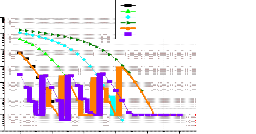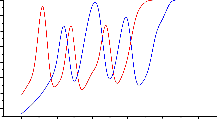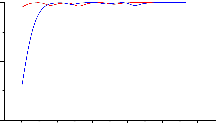Tsym
International Journal of Scientific & Engineering Research, Volume 5, Issue 3, March-2014 42
ISSN 2229-5518
A Design of FIS Based Adaptive OFDM System for Optimized Transmission of Grayscale Images
Anurag Mishra, Kanchan Sharma, and Asok De
Abstract— In this paper, we implement adaptive modulation in OFDM system using Mamdani Fuzzy Inference System (FIS) to transmit grayscale images over AWGN channel. The value of QAM modulation order (M) is decided by using a Mamdani Fuzzy Inference System that meets a maximum predefined target of bit error rate (BER). In the beginning, grayscale image transmission using adaptive M-QAM in OFDM system is carried out successfully. To improve the system performance, we further apply (7, 4) Hamming block codes on image data to be transmitted using same FIS based adaptive OFDM system. The obtained result shows that a significant improvement in terms of high PSNR, BER, SSIM and better spectral efficiency can be achieved using Fuzzy Inference based adaptive modulation scheme used in the present work.
Index Terms— BER, Mamdani Fuzzy Inference System (FIS), OFDM, PSNR, SSIM.
—————————— ——————————
he orthogonal frequency division multiplexing (OFDM) is a transmission scheme in which a single high rate data stream is divided into multiple low rate data streams. These data streams are subsequently modulated using sub- carriers orthogonal to each other. This way the inter symbol interference (ISI) and inter carrier inference (ICI) due to channel dispersion in time induced by multipath delayed spread is considerably reduced. The orthogonality of the modulation technique ensures that the data streams do not interfere with each other. The OFDM optimizes overall
channel capacity and improves through put.
The transmission of copyright content in the form of images
over AWGN channel using OFDM technique has been
successfully demonstrated by Sharma et. al [1].
The objective of the third and fourth generation mobile communication system is to integrate high speed data, video and voice signals. Adaptive OFDM or AOFDM is a potential candidate to accomplish this objective and it is also perceived
as a method to increase data capacity, throughput and efficiency. In this kind of system, the transmitter dynamically monitors the channel variations especially in SNR and BER and accordingly adapts to the transmission parameters such as modulation order, coding rate etc.
This is done to maximize efficiency. The throughput monitoring is done in the reverse channel and the adaptation is applied in the forward channel.
The adaptive modulation for OFDM was first proposed by Kalet et. al [2] in 1989. Later Chow et. al [3] and Czylwik et. al [4] revisited and modified this concept in 1995 and 1996 respectively.
However, Sharath B. Reddy et. al [5] discussed the issue of modulation, mode selection on the basis of perceived channel quality. They have argued that as the received signal fades,
————————————————
• Kanchan Sharma is with the Department of ECE, Indira Gandhi Institute
of Technology, GGSIP University, Kashmere Gate, Delhi, India (e-mail:
• Asok De is with the National Institute of Technology, Patna, Bihar, India
the modulation level is decreased to a level so as to provide an acceptable bit error rate (BER). They further state that since adaptation in every sub-carrier would be extremely complicated often sub- carriers are grouped together and adaptation is performed on the entire sub-carrier group. This is termed as sub-band adaptive modulation. According to them, the goal of the adaptive modulation is to choose the appropriate mode of transmission in each sub-carrier in order to achieve a good tradeoff between throughput and overall BER. They have taken into account the modulation mode and computed SNR to reversely calculate BER. J. Faezah and K. Sabira [6] have proposed an adaptation procedure by which the channel estimation and mode selection are done at the receiver side and this information is sent to the transmitter using a feedback channel. In their model, adaptation is done frame by frame. They have used a channel estimator to estimate the instantaneous SNR of the received signal. Based on the instantaneous SNR, the best mode is computed for the next transmission frame. This task is done by using a mode selector block. The mode selector and switching between modulator depends upon the instantaneous SNR. Further the switching between modes is done in synchronization with pre-decided switching threshold. Sheshadri K. Sastry [7] has probably for the first time demonstrated the use of Fuzzy Logic interface to simulate the design of adaptive OFDM system. In this paper, he has argued that lower order modulators such as BPSK, 4-QAM and 8-QAM will improve BER but decrease spectral efficiency and speed. On the other hand, employing higher order modulation modes such as 64- QAM, 128-QAM, 256-QAM and 512-QAM improves spectral efficiency and speed at the cost of poor BER. According to him, it is therefore a fit case of optimization by trading off spectral efficiency with BER using fuzzy logic based adaptive OFDM. For this purpose, he has relied upon switching between modulator modes on the basis of instantaneous normalized SNR (Eb /N o ) and existing mode supplied as input to the FIS.
Charu Agarwal et al [8] have successfully used Mamdani fuzzy rule based system to optimize watermark embedding in
(e-mail: asok.de@gmail.com)
IJSER © 2014
International Journal of Scientific & Engineering Research, Volume 5, Issue 3, March-2014 43
ISSN 2229-5518
grayscale images. Worldwide Mamdani Fuzzy rule based system is considered superior to other similar systems. Therefore, in the present work, we transmit grayscale images Lena and Baboon over AWGN channel using adaptive QAM technique by involving Mamdani Fuzzy Inference System. For this purpose, we use three input variables namely – Channel Eb /N o , BER and initial order for this FIS. The output of the FIS is the final modulator mode the adaptive OFDM system has to follow. The membership function used in this work is triangular. We take into account four levels of mode selection for the QAM. These are 4-QAM, 16-QAM, 64-QAM and 256- QAM. The FIS is trained using thirteen fuzzy rules developed
by taking into account the given input and output variables. It
with less number of complex addition and complex multiplication by using the IFFT.
There are two ways of adding guard interval in OFDM system. One way is to pad zeros as the guard interval. This is known as zero padding (ZP). The second method is that of cyclic prefix (CP) in which the last samples of the OFDM symbol are added as prefix which is only the cyclic extension of the OFDM symbol. Let T G denotes the length of CP in terms of samples. Then, the extended OFDM symbols have the duration T sym = T sub + T G . The received OFDM symbol ym(t) is expressed by Eqn. 5.
N-1
y (t)= X [k]e j2πfk (t-mTsym ) ,mT <t ≤ mT +nT
is concluded that the adaptive OFDM system using FIS
m ∑
k=0
m sym sym s
(5)
performs better than ordinary if-then-else control logic in
terms of tradeoff between spectral efficiency and speed on one
hand and BER on the other.
The transmitted symbol Xm [k] can be reconstructed from ym (t) by using orthogonality among the subcarriers as
y [k]= 1
y (t)e-j2πkfk (t-mTsym )dt
![]()
Tsym
∫-∞
m
N-1
= 1 ∞
X [i]e j2πkfi (t-mTsym ) e-j2πkfk (t-mTsym ) dt
The OFDM is a recent technology used in the broadband![]()
Tsym
∫-∞ ∑ m
i=0
N-1
1
T j2π(f -f )(t-mT )
communication like IEEE 802.11 wireless local area networks
(WLANs) and IEEE 802.16 broadband fixed wireless access![]()
=∑ Xm [i] T
sym
0
i k sym dt =X [k]
(6)
i=0
sym
networks in a wireless multipath environment. The basic
principle of OFDM is to split a high rate data stream into a
number of lower rate data streams which are transmitted
simultaneously over a number of sub- carriers. The dispersion
Let {ym (0), ym (1),…….., ym (N-1) be the sample values of the received OFDM symbol ym (t) at t=mT sym + nT s . Then, the integration in the modulation process of Eqn (6) can be
represented in the discrete time as given by Eqn (7)
in time caused by multipath delay spread is decreased
N −1
N −1 1 N −1
m ∑ m
∑ ∑ m
relatively due to the increase of symbol duration for lower rate
parallel sub-carriers. Intersymbol interference (ISI) is
Y [k ] =
n=0
y [n]e− j 2π kn / N =
![]()
n=0 N i =0
X [i]e j 2π in / N e− j 2π kn / N
completely eliminated by the addition of the guard time in every OFDM symbol [9].
Let Xm [k] denote the mth transmit symbol at the kth
subcarrier, m = 0, 1, 2, … ∞ and k = 0, 1, 2, … N-1. Due to
1 N-1 N-1 j2π(i-k)n/N![]()
= X [i]e =X [k]
n=0 i=0
The equation (7) is a N-point DFT of {y
m (0), ym
(1),…, y
(7)
m (N-
serial to parallel conversion, the duration of transmission time for N symbols is extended to NT s , which forms a single OFDM symbol with a length of T sym (i.e., T sym = NT s ). Let Øm,k (t) denote the mth OFDM signal at the kth subcarrier which is given as
1) and can be computed efficiently by using FFT [10].
TABLE 1: OFDM SYSTEM PARAMETERS
φm,k (t)=
e j2πf k (t-mTsym ) ,0<t ≤ T
0, elsewhere
(1)
Then the passband and baseband OFDM signals in the
continuous-time domain can be expressed respectively as
1
∞ N-1
x m (t)=Re ![]()
Φ ∑(t)
∑ Xm [k]
m,k
(2)
The OFDM system parameters used in this simulation are
Tsym m=0
k=0
mentioned in Table 1.
∞ N-1
⇒ x (t)= X [k]e j2πfk (t-mTsym )
(3)
m ∑∑ m
m=0 k=0
The continuous-time baseband OFDM signal can be sampled at t = mT sym + nT s with T s = T sym /N and fk = k/T sym to yield the corresponding discrete-time OFDM symbol as
N-1
m ∑ m
Generally OFDM systems use a fixed modulation scheme. In adaptive modulation scheme, each carrier can have a different modulation type depending on the channel condition. We use
4-QAM, 16-QAM, 64-QAM and 256-QAM modes to transmit gray scale images Lena and Baboon over AWGN channel.
Each modulation scheme provides a compromise between the
x [n]= X [k]e j2πkn/N for n=0,1,2,....,N-1.
k=0
(4)
bit error rate and spectral efficiency. If we select the highest
which turns out to be the N-point IDFT of QAM data
symbols {Xm (0), Xm (1),…,Xm (N-1)} which can be computed
modulation scheme within an acceptable BER (1E-03) then the system will have maximum spectral efficiency. The 4-QAM
IJSER © 2014 http://www.ijser.org
International Journal of Scientific & Engineering Research, Volume 5, Issue 3, March-2014 44
ISSN 2229-5518

gives poor spectral efficiency of 2 bits/sec/Hz whereas 256- QAM has the best spectral efficiency of 8 bits/sec/Hz. The selection/finalization of the modulation mode/order for each sub-channel is the key parameter of adaptive OFDM/QAM system. If the channel Eb /No is low, we prefer a lower level of QAM for the next transmission. On the contrary, if the channel Eb /No is high, we prefer higher level of QAM [11]. The design
criteria of algorithms used in the selection of modulation scheme for an adaptive system are either BER constraints or constant throughput or both, depending upon the application. As per the channel conditions, various modulation selection algorithms have been proposed recently [12-13], [16-18]. Thus, an adaptive modulation system must require the overhead information to be sent to both transmitter and receiver as both of them should know the modulation scheme being currently in use beforehand. This, in general, is perceived as one of the limitations of the adaptive modulation systems.

We propose a Mamdani fuzzy Inference system (FIS) capable of deciding the best modulation order of QAM for the next transmission. This is based on the present values of Eb /No and BER. In the present case, three parameters are fed as input to the Fuzzy Inference System (FIS) as available in the Fuzzy toolbox of Matlab software. Fig. 1 shows the block diagram of this FIS.
Fig. 1: Block diagram of Fuzzy Inference System
(1) Fuzzy Input Variables
a) Log bit error rate (LBER) represents Quality of Service (QoS) and is divided into two levels as per the inference rules defined in this work. This variation is compiled in Table 2.
TABLE 2: VARIATION OF BER AND LBER
Fig. 2: Fuzzy variation of BER
Fig. 3: Fuzzy variation of initial modulation order
c) Normalized Signal to Noise Ratio (Eb /N o ) represents the AWGN channel Eb /N o and is divided into five levels as per the inference rules used in this work. The Eb /No variation for image transmission without using (7, 4) Hamming linear block error correcting code is compiled in Table 3(a). On the other hand, Table 3(b) compiles its variation for image transmission by taking into account (7, 4) Hamming linear block error correcting code.
TABLE 3 (A) VARIATION OF CHANNEL E B /NO (WITHOUT (7, 4) HAMMING ERROR CORRECTING CODE
Range | |
VERY LOW | 4< Eb /N o <12 |
LOW | 10< Eb /No <16 |
MEDIUM | 15< Eb /No <21 |
HIGH | 18< Eb /No <26 |
VERY HIGH | Eb /N o >22 |
TABLE 3 (B) VARIATION OF CHANNEL E B /NO (WITH (7, 4) HAMMING
ERROR CORRECTING CODE)
Note from Table 2 that the selected values of BER of a required QoS ranges from 1E-01…1E-06 while it is required that the range of the fuzzy variable should be equally spaced and clearly quantifiable. In other words, the FIS should be able to give a crisp output value. It is observed that for very small values of BER as mentioned above, the FIS generates garbage. Therefore, to achieve crisp outputs, the operation LBER = log10 (BER) instead of BER is carried out for computation. Fig.
2 depicts the fuzzified values of BER used in this experiment.
b) Initial Modulation Order (init_mod_order) represents the existing modulation order and is divided into four levels ranging from 4-QAM to 256-QAM as per the inference rules used in this work. Fig. 3 shows the fuzzy variation of initial modulation order used in this work.
Fig. 4 shows the fuzzy variation of channel Eb /N o used in this work.
Fig. 4: Fuzzy variation of channel Eb /No
(2) Fuzzy Output Variables
The Mamdani Fuzzy Rule Based Inference System used in this work produces a single output known as final modulation order (fin_mod_order). Fig. 5 shows the fuzzy variation of this output parameter. It is also classified into four different levels
IJSER © 2014 http://www.ijser.org
International Journal of Scientific & Engineering Research, Volume 5, Issue 3, March-2014 45
ISSN 2229-5518
ranging from 4-QAM to 256-QAM.
Fig. 5: Fuzzy variation of final modulation order![]()
and used as an assessment of image quality. The PSNR is not perceived as a metric which behaves according to human visual system [19]. Therefore, another metric commonly known as SSIM and is based on structural vector components of the image is also used. In this manner, the visual quality of the received image is also taken into account. This is done to investigate the image transmission in a more meaningful manner. The PSNR and SSIM are given by Eqn. 8 and Eqn. 9 respectively.
(3) Fuzzy Inference Rules
The Fuzzy Inference System (FIS) used in this work is configured by developing thirteen fuzzy rules mentioned in
PSNR(I, I)=10×log10
2552 ![]()
(dB),
MSE(I, I)
(8)
Listing 1. This design of the FRBS is carried out in MATLAB
7.8 Fuzzy System Toolbox.![]()
SSIM(I, I)=
(2μ I μ I +c1 )(2σII +c2 )![]()
(μ 2 +μ 2 +c )(σ2 +σ2 +c )
(9)
Listing 1: Thirteen fuzzy rules
1. If (ber is high) and (Eb /N o is verylow) then (fin_mod_order is 4qam)
![]()
Where I is the grayscale value of the original image, I is the reconstructed grayscale image at the receiver, µI is the average
2. If (ber is high) and (Eb /N o is low) then (fin_mod_order is
of I, µ I![]()
![]()
is the average of I , σ2![]()
is the variance of I, σ2
is the
16qam)
variance of I , σ is the covariance of I and I , c =(k1 L)2, c
1 2
3. If (ber is high) and (Eb /N o is medium) then (fin_mod_order
is 64qam)
4. If (ber is high) and (Eb /N o is very high) then (fin_mod_order is 256qam)
5. If (ber is medium) and (init_mod_order is 4qam) and (E b /N o
is very low) then (fin_mod_order is 4qam)
6. If (ber is medium) and (init_mod_order is 4qam) and (E b /N o
is low) then (fin_mod_order is 16qam)
7. If (ber is medium) and (init_mod_order is 16qam) and
(Eb /N o is low) then (fin_mod_order is 16qam)
8. If (ber is medium) and (init_mod_order is 16qam) and
(Eb /N o is medium) then (fin_mod_order is 64qam)
9. If (ber is medium) and (init_mod_order is 64qam) and
(Eb /N o is medium) then (fin_mod_order is 64qam)
10. If (ber is medium) and (init_mod_order is 64qam) and
(Eb /N o is high) then (fin_mod_order is 256qam)
11. If (ber is medium) and (init_mod_order is 256qam) and
(Eb /N o is very high) then (fin_mod_order is 256qam)
12. If (ber is high) and (Eb /No is high) then (fin_mod_order is
256qam)
13. If (ber is medium) and (init_mod_order is 256qam) and
(Eb /N o is high) then (fin_mod_order is 256qam)
=(k2 L)2, L is the dynamic range of pixel values, k1 =0.01 and
k2 =0.03. These parameters are optimized by Zhou Wang & Alan Conrad Bovik [20].
Fig. 6(a): Original grayscale image Lena
In the first part of this work, grayscale Lena and Baboon images are transmitted over a AWGN channel using adaptive OFDM modulation scheme both with and without using Mamdani type FIS. These images are received at the receiver and examined for their visual quality by using two different image quality assessment metrics-peak signal to noise ratio (PSNR) and structural similarity index (SSIM). PSNR is a metric which compares the luminance value of respective pixel coefficients of test and reference images and amplifies the difference between the two. The difference is computed
IJSER © 2014 http://www.ijser.org
Fig. 6(b): Received grayscale image Lena at Eb /N o =12
International Journal of Scientific & Engineering Research, Volume 5, Issue 3, March-2014 46
ISSN 2229-5518

1
0.1
0.01
1E-3
1E-4
1E-5
1E-6
1E-7
4QAM
16QAM
64QAM
256QAM
ADAPTIVE WITH FUZZY ADAPTIVE WITHOUT FUZZY

5 10 15 20 25 30
E /N (in dB)
Fig. 8: Plot of BER w.r.t. Channel Eb /N o for transmitted Lena image
Fig. 7(a): Original grayscale image Baboon
PSNR = 42.5151 SSIM= 0.9961
100
90
80
70
60
50
40
30

![]()
WITH FUZZY WITHOUT FUZZY

20
5 10 15 20 25 30
E /N (in dB)
b o
Fig. 9: Plot of PSNR w.r.t. Channel Eb /No for the transmitted Lena image
Fig. 7(b): Received grayscale image Baboon at E b /N o =12
Figs. 6(a) and 7(a) shows the original grayscale Lena and Baboon image respectively. Figs. 6(b) and 7(b) shows the received Lena and Baboon images at Eb /N o =13. Moreover, at the receiver side, we also calculate BER of the received image w.r.t transmitted image. The role of the fuzzy logic controller
1.0
0.8
0.6

![]()
5 10 15 20 25 30
E /N (in dB)
WITH FUZZY WITHOUT FUZZY
by observing the values of BER, init_mod_order and Channel Eb /N o is to give a crisp output indicating the modulation order of QAM for the next transmission. The same information is conveyed to both the transmitter and the receiver for the next transmission. We compute the values of BER, QAM order for the subsequent transmission PSNR and SSIM for transmitted images with respect to Channel Eb /N o . Figs. 8-10 respectively depict the plots of BER, PSNR and SSIM with respect to Eb /N o both without and with using Mamdani type Fuzzy Inference System (FIS) for transmitted grayscale Lena image. The computed values are represented in the same plot depicting with or without using FIS to give a comparative idea between them. Thereafter, we transmit Baboon grayscale image over AWGN channel using same adaptive OFDM scheme with and without Mamdani type FIS. In this case, the values of the same parameters are computed w.r.t Channel Eb /N o . These parameters are plotted and are shown in Figs.
11-13 respectively.
A careful observation of these results leads us to the
following interpretation:
1. In this paper, the mode selection for QAM order is done
Fig. 10: Plot of SSIM w.r.t. Channel E b /No for transmitted Lena image by using Mamdani Fuzzy Inference System (FIS) in case of transmission of grayscale images over AWGN channel. We have successfully demonstrated the potential of optimizing transmission of grayscale images over AWGN channel using fuzzy logic. Although, in principle, the FIS itself is a non adaptive intelligent system, yet a good degree of adaptation to select the order of the modulation scheme is introduced in the procedure used in this work.
This is done by switching the modulation order from 4-16,
16-64 and 64-256 or vice versa in the present work. It will be an interesting avenue to investigate the level of adaptability of the intelligent system by making it hybrid with either a BPN or an RBF neural network.
2. The FIS used in this work is trained by using three input parameters – Channel Eb /No , BER and the initial QAM order to obtain a crisp output value which is rounded off to be referred to as the final QAM order. All other experiments which used a similar or a different kind of FIS to transmit digital content in any form using QAM technique use channel Eb /N o and initial QAM order only as its inputs [7].
IJSER © 2014 http://www.ijser.org
International Journal of Scientific & Engineering Research, Volume 5, Issue 3, March-2014 47
ISSN 2229-5518

3. As a matter of comparison, the PSNR of non-adaptive or fixed transmission scheme is low and SSIM of non-adaptive scheme saturates at high Channel Eb /N o [1]. This is because the low constellation size limits the maximum source data that can be transmitted. On the contrary, for an adaptive modulation system, the amount of transmitted data varies in accordance with the channel parameters and this leads to achieving a high PSNR and SSIM after reception.
4QAM
AWGN channel using adaptive QAM modulation scheme, the
FIS is the best option available to us.

As mentioned in Section II, we transmit grayscale images:- Lena and Baboon in the same manner described above by using (7, 4) Hamming linear block error correcting code. All previous parameters are computed for grayscale Lena and Baboon images.
1
0.1
0.01
1E-3
1E-4
16QAM
64QAM
256QAM
ADAPTIVE WITH FUZZY ADAPTIVE WITHOUT FUZZY
1
0.1
0.01
4QAM
16QAM
64QAM
256QAM ADAPTIVE
ADAPTIVE WITH (7,4)HAMMING ECC
1E-5
1E-3
1E-6
1E-4
1E-7
3 5 8 10 13 15 18 20 23 25 28 30 33
E /N (in dB)
1E-5
1E-6
Fig. 11: Plot of BER w.r.t. Channel Eb /N o for transmitted Baboon
1E-7
3 5 8 10 13 15 18 20 23 25 28 30 33
E /N (in dB)
100

![]()
WITH FUZZY WITHOUT FUZZY
Fig. 14: Plot of BER w.r.t channel E b /No for transmitted Lena using
(7, 4) Hamming error correcting code
90
80
140

![]()
WITH (7,4) HAMMING ECC WITHOUT ECC
70
120
60
100
50
40 80
30 60
5 10 15 20 25 30
40
E /N (in dB)
b o
Fig. 12: Plot of PSNR w.r.t. Channel Eb /N o for transmitted Baboon
![]()
WITH FUZZY
5 10 15 20 25 30
E /N (in dB)
Fig. 15: Plot of PSNR w.r.t Channel Eb /N o for transmitted Lena
1.0

WITHOUT FUZZY
image using (7, 4) Hamming error correcting code
0.8
1.0

![]()
WITH (7,4)HAMMING ECC WITHOUT ECC
0.6
0.8
5 10 15 20 25 30
E /N (in dB)
0.6
b o
Fig. 13: Plot of SSIM w.r.t. Channel E b /No for transmitted Baboon image
5 10 15 20 25 30
E /N (in dB)
4. In an adaptive scheme when channel conditions are bad,
the quality of transmission can be improved upon by
Fig. 16: Plot of SSIM w.r.t Channel Eb /N o
for transmitted Lena
transmitting the data at a much lower rate i.e., adapting for a lower modulation order. On the other hand, if Channel Eb /N o and BER are conducive to transmission, higher modulation
image using (7, 4) Hamming error correcting code
The corresponding plots are depicted in Figs. 14-16 respectively for grayscale Lena image. For grayscale Lena transmitted in this manner, a comparative plot of BER w.r.t
order can be selected. This kind of switching is not possible in
a non-adaptive transmission system. Even though, if we try to
Channel Eb /No
with and without using error correcting code
implement an adaptive system by using a simple if-then-else logic, it does not represent a real life situation. This is clearly evident by the results presented in the plots of Figs. 8-10 and Figs. 11-13 respectively for Lena and Baboon. Thus, to optimize the transmission of the grayscale images over
is shown in Fig. 14. Similar plot for PSNR and SSIM w.r.t
Channel Eb /N o with and without ECC are respectively shown in Figs. 15-16. In the first part of this work, it is clearly established that FIS produces better results in comparison to ordinary if-then-else logic. Therefore, in the second part of this
IJSER © 2014 http://www.ijser.org
International Journal of Scientific & Engineering Research, Volume 5, Issue 3, March-2014 48
ISSN 2229-5518

work only FIS based adaptive OFDM modulation is implemented. However, a comparison of the results is made on the basis of implementing the transmission with or without ECC.
4QAM
16QAM
Channel Eb /No as per Fig. 15 for grayscale Lena and Fig. 18 for grayscale Baboon transmitted with the error correcting code. It can be easily noted that PSNR gets saturated at lower Channel Eb /N o values. A similar result is also presented by Sharma et. al [1] wherein it is shown that PSNR does get saturated at a
much lower Channel Eb /No value. However, we found that
1
0.1
0.01
1E-3
1E-4
1E-5
1E-6
1E-7
64QAM
256QAM ADAPTIVE
ADAPTIVE WITH (7,4) HAMMING ECC
3 5 8 10 13 15 18 20 23 25 28 30 33
E /N (in dB)
PSNR follows a stable path in [2] unlike in this case. The instability in PSNR plot is attributed to adaptable switching between QAM orders optimized by the used FIS while it gets saturated at lower channel Eb /No with the application of error correcting code.
3. An identical behavior is depicted for SSIM plots w.r.t
Channel SNR both for grayscale Lena and grayscale Baboon
transmitted with error correcting codes. The plot of this
b o
quantity is also found to be unstable like PSNR and they do
Fig. 17: Plot of BER w.r.t Channel Eb /N o for transmitted grayscale
Baboon using (7, 4) Hamming error correcting code
get saturated at lower Channel Eb /N o
with an application of
100
90
80
70
60
50
40
30
![]()
![]()
WITH (7,4)HAMMING ECC WITHOUT ECC

5 10 15 20 25 30
E /N (in dB)
error correcting codes. (Figs. 16 & 19 respectively for Lena and
Baboon)
It should be noted that the notion of adaptability introduced in
the present work does not have any relationship with the
application of fuzzy logic with or without application of error correcting code. This is because the Fuzzy Inference System (FIS) as an intelligent system lacks in adaptability which can be successfully supplemented by integrating it with an Artificial Neural Network (ANN) or combining it (FIS) with an evolutionary algorithm such as genetic algorithm (GA). The
b o issue of adaptability discussed in this paper or in other
Fig. 18: Plot of PSNR w.r.t channel E b /No for transmitted Baboon using (7, 4) Hamming error correcting code
![]()
WITH (7,4)HAMMMING ECC
references mentioned in Section I is limited to the switching for mode selection of the QAM scheme. The fuzzy inference system is used to optimize the process of switching which is
1.0
0.9
0.8

WITHOUT ECC
5 10 15 20 25 30
E /N (in dB)
an important aim/objective of this work.
In view of this discussion, we conclude that optimized transmission of grayscale Lena and Baboon images over AWGN channel using adaptable mode selection of the QAM scheme is successfully accomplished by means of Mamdani type Fuzzy Inference System (FIS). The results are further
b o
improved upon by applying (7, 4) Hamming linear block error
Fig. 19: Plot of SSIM w.r.t channel Eb /No for transmitted Baboon using (7, 4) Hamming error correcting code
Figs. 17-19 depict similar plots obtained by transmitting
Baboon grayscale image.
A close observation of these results leads us to following interpretation:
1. These results clearly depict a similar adaptive behavior in
terms of mode selection for the QAM scheme to be chosen next. Fig. 14 and Fig. 17 indicate that the mode selection is executed in the same manner as without error correcting code. However, with error correcting code, the switching does take place at a lower Channel Eb /No in comparison to that without ECC. A similar result is presented by Sharma et. al [1] wherein it is clearly indicated that with the application of error correcting code, the transmission of grayscale images can be accomplished at a much lower value of Channel Eb /No .
2. There is a resemblance in the variation of PSNR w.r.t
correcting code while transmitting the grayscale images over the said channel. It shall, however, be an interesting avenue to examine and analyze the integration of Artificial Neural Networks (ANNs) with the fuzzy logic employed in this case so that the necessary adaptability which an FIS lacks otherwise can be successfully compensated.
[1] Kanchan Sharma, Anurag Mishra, Asok De, “Robust Watermarked Image Transmission on OFDM Wireless Network”, proceedings of IEEE CCECE 2012
[2] I. Kalet, “The multitone channel,” IEEE Transaction on Communication, vol. 37, Feb. 1989, pp. 119–124
[3] P.S.Chow, J.M.Cioffi and J.A.C Bingham, “A practical discrete multitone transceiver loading algorithm for data transmission over spectrally shaped channels”, IEEE Transactions Communications, vol. 38, 1995 pp. 772-775
IJSER © 2014 http://www.ijser.org
International Journal of Scientific & Engineering Research, Volume 5, Issue 3, March-2014 49
ISSN 2229-5518
[4] A. Czylwik, “Adaptive OFDM for wideband radio channels”, Global
Telecommunications Conference, vol. 1, Nov 1996, pp. 713-718
[5] Sharath B. Reddy, Tevfik Yucek and Huseyin Arslan, ” An Efficient Blind Modulation Detection Algorithm for Adaptive OFDM Systems”, proceeding of 8th Vehicular Technology Conference, VTC 2003, vol. 3, 2003, pp. 1895 – 1899
[6] J. Faezah, and K. Sabira, “Adaptive Modulation for OFDM Systems”, International Journal of Communication Networks and Information Security IJCNIS, vol. 1, no. 2, August 2009
[7] K. Seshadri Sastry and M. S. Prasad Babu, “Adaptive Modulation for OFDM system using Fuzzy logic interface”, IEEE ICSESS, 2010, pp. 368-371
[8] Charu Agarwal, Anurag Mishra, Arpita Sharma, “Digital Image
Watermarking in DCT domain Using Fuzzy Inference System”,
proceedings of IEEE CCECE 2011, pp. 822-825
[9] Hui Liu, Guoqing Li ,“OFDM-Based Broadband Wireless
Networks Design and Optimization”, John Wiley & sons, Mc. publication, 2005
[10] Yong Soo Cho, Jaekwon Kim, Won Young Yang, Chung G. Kang, “MIMO-OFDM Wireless communications”, John Wiley & Sons (Asia) Ltd,, 2010
[11] E. Lawrey, “Multiuser OFDM, ”Fifth International Symposium on signal processing and its applications”, ISSPA’99, 1999
[12] T. Keller and L. Hanzo, “Adaptive modulation techniques for duplex OFDM transmission”, IEEE Transaction on Vehicular Technology, vol. 49, no. 5, Sept. 2000, pp. 1893–1906
[13] J. Torrence and L. Hanzo, “Optimization of switching levels for
adaptive modulation in slow Rayleigh fading”, IEE Electron.
Letter, vol. 32, no. 13, 1996, pp. 1167–1169
[14] Nee, V., Prasad, R., “OFDM for Wireless Multimedia
Communications”, Artech House, London, UK, 2000
[15] Steele, R. and Webb, W., “Variable Rate QAM for Data
Transmission over Rayleigh Fading Channels”, proceedings of
Wireless’91, Calgary, Alberta, Canada, 1991, pp. 1-14
[16] Keller, T., Hanzo, L., “Adaptive Modulation Techniques for
Duplex OFDM Transmission”, IEEE Transactions on Vehicular
Technology, September, vol. 49, no. 5, 2000, pp. 1893-1906
[17] Huiqin Du, Pei-Jung Chung, Bernard Mulgrew,” Robust Adaptive Modulation With Imperfect Channel Information”, 17th European Signal Processing Conference EUSIPCO 2009, Glasgow, Scotland, August 2009
[18] Chang Wook Lee and Gi Joon Jeon, “An Efficient Adaptive
Modulation Scheme for Wireless OFDM Systems“, ETRI Journal, vol. 29, no. 4, August 2007
[19] Anurag Mishra, Arunna Jain, Manish Narwaria, Charu Agarwal,” An experimental study with objective quality assessment of watermarked images,” International Journal of Image Processing (IJIP) , pp. 199-219, vol. 5(2), 2011
[20] Zhou Wang, Alan Conrad Bovik, Hamid Rahim Sheikh and Eero
P. Simoncelli,” Image Quality Assessment: From Error Visibility to
Structural Similarity”, IEEE Transactions on Image Processing, vol.
13, No. 4, pp. 600-612, April 2004
IJSER © 2014 http://www.ijser.org